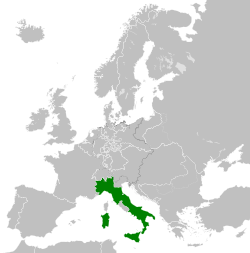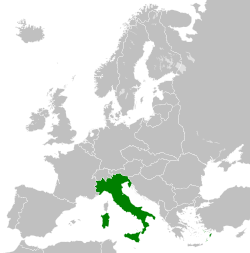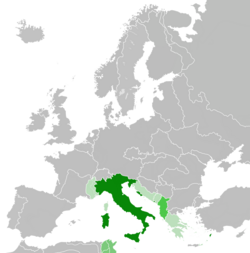Kingdom of Italy Regno d'Italia (Italian) | |||||||||||||||||||||
|---|---|---|---|---|---|---|---|---|---|---|---|---|---|---|---|---|---|---|---|---|---|
| 1861–1946 | |||||||||||||||||||||
| Motto: FERT (Motto for the House of Savoy) | |||||||||||||||||||||
| Anthem: (1861–1943; 1944–1946) Marcia Reale d'Ordinanza ("Royal March of Ordinance") (1924–1943) Giovinezza ("Youth") (1943–1944) La Leggenda del Piave ("The Legend of Piave") | |||||||||||||||||||||
 Colonies and territories held by the Italian Empire in 1939 | |||||||||||||||||||||
| Capital | |||||||||||||||||||||
| Largest city | Rome | ||||||||||||||||||||
| Official languages | Italian | ||||||||||||||||||||
| Religion | 96% Roman Catholicism (state religion from 1929) | ||||||||||||||||||||
| Demonym(s) | Italian | ||||||||||||||||||||
| Government | Unitary constitutional monarchy
| ||||||||||||||||||||
| King | |||||||||||||||||||||
• 1861–1878 | Victor Emmanuel II | ||||||||||||||||||||
• 1878–1900 | Umberto I | ||||||||||||||||||||
• 1900–1946 | Victor Emmanuel III | ||||||||||||||||||||
• 1946 | Umberto II | ||||||||||||||||||||
| Prime Minister | |||||||||||||||||||||
• 1861 (first) | Count of Cavour | ||||||||||||||||||||
• 1922–1943 | Benito Mussolini[a] | ||||||||||||||||||||
• 1945–1946 (last) | Alcide De Gasperi[b] | ||||||||||||||||||||
| Legislature |
| ||||||||||||||||||||
| Senate | |||||||||||||||||||||
| |||||||||||||||||||||
| History | |||||||||||||||||||||
| 17 March 1861 | |||||||||||||||||||||
| 4 October 1866 | |||||||||||||||||||||
| 20 September 1870 | |||||||||||||||||||||
| 20 May 1882 | |||||||||||||||||||||
| 26 April 1915 | |||||||||||||||||||||
| 28 October 1922 | |||||||||||||||||||||
| 22 May 1939 | |||||||||||||||||||||
| 27 September 1940 | |||||||||||||||||||||
| 25 July 1943 | |||||||||||||||||||||
• Republic | 10 June 1946 | ||||||||||||||||||||
| Area | |||||||||||||||||||||
| 1861[1] | 250,320 km2 (96,650 sq mi) | ||||||||||||||||||||
| 1936[1] | 310,190 km2 (119,770 sq mi) | ||||||||||||||||||||
| Population | |||||||||||||||||||||
• 1861[1] | 21,777,334 | ||||||||||||||||||||
• 1936[1] | 42,993,602 | ||||||||||||||||||||
| GDP (PPP) | 1939 estimate | ||||||||||||||||||||
• Total | 151 billion (2.82 trillion in 2019) | ||||||||||||||||||||
| Currency | Lira (₤) | ||||||||||||||||||||
| |||||||||||||||||||||
The Kingdom of Italy (Italian: Regno d'Italia, Italian: [ˈreɲɲo diˈtaːlja]) was a state that existed from 17 March 1861, when Victor Emmanuel II of Sardinia was proclaimed King of Italy, until 10 June 1946, when the monarchy was abolished, following civil discontent that led to an institutional referendum on 2 June 1946. This resulted in a modern Italian Republic. The kingdom was established through the unification of several states over a decades-long process, called the Risorgimento. That process was influenced by the Savoy-led Kingdom of Sardinia, which was one of Italy's legal predecessor states.
In 1866, Italy declared war on Austria in alliance with Prussia and, upon its victory, received the region of Veneto. Italian troops entered Rome in 1870, ending more than one thousand years of Papal temporal power. In the last two decades of the 19th century, Italy developed into a colonial power, and in 1882 it entered into a Triple Alliance with the German Empire and the Austro-Hungarian Empire, following strong disagreements with France about their respective colonial expansions. Although relations with Berlin became very friendly, the alliance with Vienna remained purely formal, due in part to Italy's desire to acquire Trentino and Trieste from Austria-Hungary. As a result, Italy accepted the British invitation to join the Allied Powers during World War I, as the western powers promised territorial compensation (at the expense of Austria-Hungary) for participation that was more generous than Vienna's offer in exchange for Italian neutrality. Victory in the war gave Italy a permanent seat in the Council of the League of Nations, but it did not receive all the territories it was promised.
In 1922, Benito Mussolini became prime minister of Italy, ushering in an era of National Fascist Party government known as "Fascist Italy". Authoritarian rule was enforced, crushing all political opposition while promoting economic modernization, traditional values, and territorial expansion. In 1929, the Italian government reconciled with the Roman Catholic Church through the Lateran Treaties, which granted independence to the Vatican City. The following decade presided over an aggressive foreign policy, with Italy launching successful military operations against Ethiopia in 1935, Spain in 1937, and Albania in 1939. This led to economic sanctions, departure from the League of Nations, growing economic autarky, and the signing of military alliances with Germany and Japan.
Fascist Italy entered World War II as a leading member of the Axis Powers in 1940 and despite initial success, was defeated in North Africa and the Soviet Union. Allied landings in Sicily led to the fall of the Fascist regime and the new government surrendered to the Allies in September 1943. German forces occupied northern and central Italy, established the Italian Social Republic, and reappointed Mussolini as dictator. Consequentially, Italy descended into civil war, with the Italian Co-belligerent Army and resistance movement contending with the Social Republic's forces and its German allies. Shortly after the surrender of all fascist forces in Italy, civil discontent prompted an institutional referendum, which established a republic and abolished the monarchy in 1946.
- ^ a b "Italy in 150 years – summary of historical statistics 1861–2011" (PDF) (in Italian). Istat. p. 135. Archived from the original (PDF) on 19 March 2016. Retrieved 27 November 2016.





